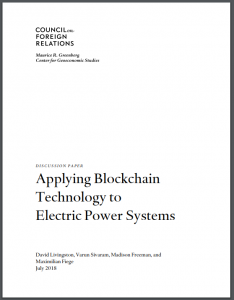Full Title: Applying Blockchain Technology to Electric Power Systems
Author(s): David Livingston, Varun Sivaram, Madison Freeman, and Maximilian Fiege
Publisher(s): Council on Foreign Relations
Publication Date: July 1, 2018
Full Text: Download Resource
Description (excerpt):
Electric power systems around the world are rapidly changing. For over a century, these systems have relied largely on centralized, fossil fuel plants to generate electricity and sprawling grids to deliver it to end users. Utilities had a straightforward objective: provide electricity with high reliability and at low costs. But now, governments have new ambitions for electric power systems. Many are requiring these systems to rely heavily on volatile wind and solar power; several are also aiming for a high share of electric vehicles (EVs), which can strain grids. Further complicating the matter, customers are installing their own equipment—from solar panels to batteries and smart appliances—to control their production and consumption of electricity.
As utilities struggle to sustain reliable service, meet new policy objectives, and cope with rising complexity, innovators are peddling a putative solution: blockchain technology. Its most popular application is in recording peer-to-peer transactions of bitcoin and other so-called cryptocurrencies. In theory, blockchain technology could enable swift, frictionless, secure, and transparent currency trading. But the potential applications of blockchain extend well beyond currency trading; blockchain could also be used to cope with increasingly complex electric power systems.
In 2017, start-up companies raised over $300 million to apply blockchain technology to the energy sector in myriad ways. Some of these start-ups want to enhance existing markets for trading electricity or even to create new ones, for example, by using blockchain to facilitate peer-to-peer transactions that bypass a central utility or retail energy provider. Others hope to use blockchain to track the production of clean energy. Still others have proposed using blockchain to make it easier to pay for charging EVs, raise funds to deploy clean energy, manage customer appliances, and more.
Proponents of blockchain technology liken its potential to that of the internet three decades ago. But so far, little of this potential has been realized. Although most blockchain ventures aim to replace today’s centralized power system with decentralized energy trading, the ventures most likely to achieve commercial traction in the coming years will largely work within the existing system and partner with incumbents such as utilities.
Because the electric power sector is highly regulated, policymakers will play a crucial role in determining how much of blockchain’s potential can be realized. In order to effectively regulate blockchain, policymakers should first invest in understanding it. Next, they should actively support the development of technical standards. And finally, policymakers should make it possible for blockchain ventures to set up small-scale demonstration projects, for example, by creating regulatory sandboxes that loosen electric power sector regulations to permit experimentation.
